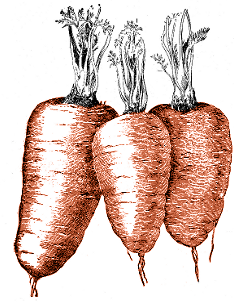Posts tagged ‘pea’
Posted in Experimentation, Garden Diary, Practicalities, The Old Garden In Bristol on Friday, May 27th 2016 (10.33 PM).
There haven’t been any posts here in the past month, partly because I was waiting to see if the Zierkürbis seeds would germinate. As they haven’t, I suspect it is safe to say that they were too old to grow successfully.
Not much else has been very successful in the past month, largely because the local slug and snail population has woken up to the fact that there are fresh tender new seedlings all over my garden. So, seedling after seedling has sprung up only to have its baby leaves immediately nipped off. The whole line of pea plants seemed to be doing reasonably well, until over the course of a few days last week something sluglike went eating its way along the row, a couple of plants per night. So far only one is left – ironically, one that The Child Who Likes Fairies grew by accident in the bucket of stale compost she has been given to “play digging” in.
So now, a whole new round of seed-sowing has started, this time with the idea that everything will be germinated indoors, and kept indoors overnight until it is chunky enough to survive a brief slug attack. The next round of peas will be going into containers, on the grounds that previously, when growing peas in containers, they stayed remarkably slug-free. We’ve switched pea varieties too, because the peas we were using previously had less than a 50% success rate at germinating: not great if you want to try to get back on track quickly and only have limited space to do it in.
pea, slug, snail, zierkürbis
Posted in Experimentation, Garden Diary, The Old Garden In Bristol on Thursday, April 21st 2016 (9.52 PM).
Seven of the pea seedlings that we all sowed together a fortnight or so ago were looking healthy, upright, and if anything a bit constricted; so this afternoon with the childrens’ help I planted them out in the back bed. Now, I’m just paranoid that slugs are going to descend on them en masse overnight and chomp them off at the ground. I’ve already been outside twice tonight with a lantern to try to detect the oncoming horde, but haven’t spotted any at all so far.
The seed peas had been sown in “expensive” fibre pots from the garden centre. However, I’m not sure they worked as well as they could have: unlike when I have done that in previous years, the pots seemed to stay very solid and the seedlings found it hard to push roots through their walls. So, the next batch of seed peas have been sown in cheap fibre pots from the pound shop. I’m not sure that “under 50%” was the greatest germination success rate, so hopefully the next batch will be better.
germination, pea
Posted in Decorative, Experimentation, Garden Diary, Practicalities, The Old Garden In Bristol on Sunday, April 17th 2016 (9.18 PM).
This afternoon, I finished weeding the rosebay willowherb, until more shoots spring up at least. Weeded every shoot I could see, dug up every rhizome I could find, levelled out the soil and spread a layer of compost across the top.
The sowing plan for the bed starts with: peas at the back, against the trellis. Now, I’ve had issues with pea support in the past, and I suspected that the laths of the trellis are a bit big for a pea plant to wrap a tendril around, so the trellis has been covered in green plastic pea netting. It’s not the prettiest solution but it’s not too obtrusive; and I’m sure the vines of the back neighbour’s honeysuckle will love clinging onto it too.
In the front of the bed, we have scattered various seeds, mostly flowers, in the hope that the will grow up in front of the pea plants without eclipsing them entirely. We’ve scattered handfuls of:
- Cornflower, Centaurea cyanoides “Blue Diadem”
- Night scented stocks, Matthiola bicornis
- Corn marigold, Chrysanthemum segetum
- Poppy, Papaver rhoeas “Flanders”
- Swiss chard, Beta vulgaris vulgaris Cicla-Group “Five Colour Silverbeet”, because Gretchen has spotted it elsewhere and liked the different colours of the leaves.
- Tree spinach, Chenopodium giganticum “Magenta Spreen”, scattered from a packet I bought a couple of years ago and intended to sow but never did. The aim of the tree spinach is much as it was when I bought the packet: it has been sowed in the left-hand end of the bed, a dark and fairly damp corner where not much grows apart from dandelions. Tree spinach might prefer sun, but will hopefully cope with the shade there; and there won’t be any peas at that end that it might crowd out.
There are also nasturtiums, Tropaeolum majus “Empress of India”, apparently “a classic Victorian variety” according to the Internet, sowed in a couple of spots, their seeds like tiny miniature brains. The key to all of this, of course, is the idea that the peas are going to clamber up high enough and quick enough that none of the stuff around them will cause any problems. The other key, which you might have realised, is that nearly all of the ornamental (or semi-ornamental) stuff is self-seeding. Hopefully, once everything is set up, everything will keep on going year after year, or at least until we move house.
This is all very experimental and no doubt a Proper Gardener would tell us we were trying to cram far too many plants into a tiny space. However, we will wait and see. I won’t be surprised if not everything develops, or at least, doesn’t grow exactly how I originally envisaged things. It might need a bit of tweaking next year, or it might all come up again, irregular but satisfactory.
I’ve given up on the calendula seeds mentioned previously, and bought a new packet. Into pots, we sowed:
- More calendula, obviously.
- And more Tropaeolum majus.
- Mixed rocket leaves
- A different dwarf sunflower, Helianthus annuus “Choco Sun”, allegedly one of the smallest sunflower varieties available. Short enough for a toddler to sniff, I hope.
And with a general tidy-up, the garden is looking reasonable again. The back bed may be bare soil now, but hopefully within a month or two it will be full of greenery, and mostly the greenery we intended, too. In the tidy-up a lot of the wooden containers were thrown away, their wood rotted too far to save them, but that leaves us a good terracotta core. The plants we bought and potted up 2½ weeks ago are settling in nicely: the fennel looking lively, the thymes putting on new growth, and the marjoram already starting to fill up its pot. I’m rather pleased with how quickly things have been turned around. Even if things aren’t perfect yet, there’s not too much more tidying up left to do.
calendula, chard, corn marigold, cornflower, creeping thyme, fennel, french marjoram, green fennel, lemon thyme, marigold, marjoram, nasturtium, pea, poppy, rosebay willowherb, sowing, sowing plan, sunflower, swiss chard, thyme, tree spinach, weeding, Tropaeolum
Posted in Experimentation, Garden Diary, Practicalities, The Old Garden In Bristol on Thursday, April 14th 2016 (9.46 PM).
The first few pea shoots started to break the surface a couple of days ago, making it five days after sowing. Rather fast, I thought; only a few have come up so far, which makes me worry I’ve kept them too damp or something.
In the meantime I’ve been clearing out the back bed, into which the peas are going to be transplanted once large enough. A few years ago, I spent weeks clearing bindweed out of it, going through the soil archaeologically to excavate the tiniest pieces of bindweed rhizome. Now, after a couple of years of baby-rearing abandonment, it’s been colonised by rosebay willowherb. So I’m going through the soil almost archaeologically again, pulling out chunky pieces of rosebay willowherb rhizome this time. Hopefully I have got as much as possible: if I’ve missed any, once there are other plants in there the archaeological approach isn’t likely to work very well. I will have to resort to pulling up each shoot again and again until the rhizomes are exhausted.
There is still no signs of the calendula seeds we sowed twelve days ago germinating. To be honest I have no idea how long they normally take to germinate, but as I usually tend towards the impatient side, and I was always a bit skeptical that the packet would still contain viable seeds, I am suspecting that nothing is going to appear. Pushing on ahead, today we planted a pot of borage seeds (Borage officinalis) and another of poached eggs, which is hardly the nicest plant name I’ve ever come across, so I think I’ll just refer to it as Limnanthes douglasii from now on. Both pots will only really be large enough for one plant of each; a rather small plant in the borage’s case; but that will suffice. There may be just enough room for one borage plant in the back bed too, in front of the peas, but I doubt it with everything else I’d like to squeeze in there.
We did also buy a few plants from the greenhouse at St Werburghs City Farm, which sells plants as part of its horticulture training scheme for adults with special needs. A couple of chervil (Anthriscus cerefolium) and a dwarf variety of sunflower, which hopefully should grow to about the same height as the children. They were repotted this afternoon, despite a cold shower of rain, and with the children “helping” moving the compost about.
borage, calendula, chervil, germination, limnanthes douglasii, pea, rosebay willowherb, sowing, sunflower, weeding
Posted in Children, Garden Diary, The Old Garden In Bristol on Friday, April 8th 2016 (9.59 PM).
We had the children planting peas yesterday. Never mind cress: in theory they are surely an ideal children’s plant? They germinate fairly quickly and easily, grow fairly fast, have interesting shapes as they climb, and produce something you can eat. Moreover, we’ve always had a reasonable amount of success with peas in the past, despite my moans of despair at them falling over rather than climbing (see the archives on here for various moans of woe).
Some would think that sitting two toddlers down at the kitchen table with a bowlful of “soil” (actually seed compost) would be a Bad Idea, but I was impressed just how well it worked. Give each child a small fibre pot and a spoon, and they quickly work out what to do. When it’s about half-full, hand them a pea, let them drop it in, and when they look away make sure it’s nicely aligned in the middle of the pot. Watch them spoon more compost in, tamping it down occasionally, and there you are.
So now we have eighteen pea seeds in pots on the windowsill, waiting to see if they come up, and waiting to see if, if and when they do, the children remember that they planted them. When they do come up, we are planning to try them in the back bed this time, which does make me worry if they will survive without being savaged by slugs also. Fingers crossed, I suppose.
pea, sowing
Posted in Garden Diary, Photobloggery, The Old Garden In Bristol on Saturday, December 1st 2012 (8.36 PM).
This week, it really feels as if the garden is properly getting itself going. More and more insects are out and about, and more things are starting to come alive. The lettuce and calendulas sown three weeks ago have just made their first appearance above ground, and the pea seedlings which have been growing on the kitchen windowsill are getting larger and larger, stretching their tendrils like the most grotesque of scarecrows. Today I started hardening them off ready for planting out; I probably should have done it earlier.
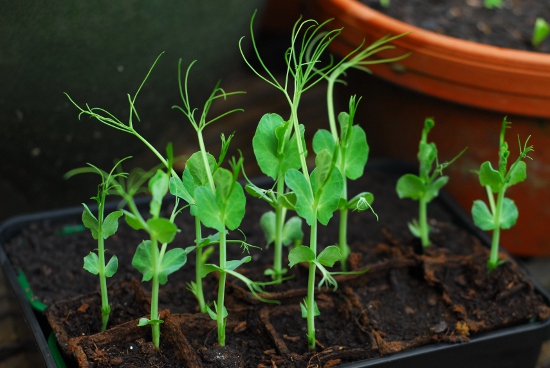
More peas will start germinating soon. The first batch of this year’s potato crop went into the ground today too – well, into their container. This year we picked Red Duke Of York, as something we are unlikely to see in the greengrocers, and I’ve tried to squeeze four tubers into the container rather than last year’s three. The second batch will be planted in about a month’s time.
To get the potatoes, we popped over to the Riverside in Southville. Naturally, we were rather tempted by their selection of herb plants. Possibly too tempted: intending go there purely to get potatoes, we also came home with a black peppermint, some sweet peas, and two fennel plants. The fennel is instead of the dill we grew last year; I will explain more about that later.
black peppermint, calendula, fennel, lettuce, marigold, mint, pea, peppermint, potato, spring, sweet pea
Posted in Garden Diary, Retrospective, The Old Garden In Bristol on Saturday, July 7th 2012 (2.50 PM).
A week ago, we passed the midpoint of the calendar year; a week or two before that, the midpoint of the solar year. A good place, I thought, to put together a little bit of a summary on how things are growing so far. With the weather, of course, it’s not going too well. There are bright spots, though. Here’s a summary, at least of the plants that are worth talking about.
- Potatoes: they’re not quite ready yet. Of the two batches of potatoes I planted, the first seem to be doing quite well. The second, though, are having problems. When I planted them, they were already far too leggy, and they stayed far too leggy as they grew. Because of that, they haven’t coped with the weather at all: they have flopped all over the place. For some reason, floppy potato plants are far more attractive to slugs and snails than tidy, well-behaved ones are.
- Green beans: the first batch were planted far too early, but happily sat in their pot for a month or two until the weather was warm enough. They’ve just reached the top of their poles, buds are starting to come, and the second batch I germinated are now ready to pot on.
- Runner beans: these went in a bit later than the green beans, and are already in full flower. They seem to be a little reluctant to set fruit, though; only one or two tiny embryo beans have been spotted so far. The standard advice for persuading beans to set seems to be “spray the flowers with water”, but given the weather I don’t really think that would help. Most of the salad leaves I planted around the base of the beans completely bolted before the weather turned wet, but some of the lettuce has been harvested and eaten.
- Garlic: also looking a bit windblown, and also not quite ready yet. They have, in the past couple of days, very quickly put forth a scape on each plant: the scapes are now safely in the fridge for eating.

- Peas: if you ever hear anyone say to you “semi-leafless peas are self-supporting when sown in a block”, put your hands over your ears. And tape their mouth shut. And shoot them. This may be true in theory, but in reality I found that the growing peas could not cope at all with the weight of their pods. The first batch has already been harvested; and when I took them down, I could see just how twisted and serpentine the later batches have become. A final extra-big batch has been sown and planted on, spaced slightly further apart and with a lot more support provided by horizontal strings: I suspect the tight planting of the first couple of batches was the cause of the large number of pods with just two or three peas inside.
- Courgettes: the first of these were planted on about a month ago now, and seem to be doing fairly well. The first few flowers have bloomed: the problem is that with only a handful of plants, and the flowers only lasting a few days, it is difficult to get male and female flowers in bloom at the same time.
- Lemon balm: I picked these seeds up at the Bristol Seed Swap at the Cube Cinema back in February. Back in May, I put them in a pot, and waited for them to grow. Nothing happened, and I assumed something had gone wrong: all died, all rotted, all eaten by evil weevils. However, just this morning, I spotted one tiny seedling starting to emerge. Maybe it will turn out to be a lemon balm plant. So there’s a bright spot.
Writing out a list like this makes me aware of just how many different plants there are in the garden at the moment: I haven’t even had space to mention the mint; the basil mint; the peppermint; camomile; chervil; borage; French marigolds; English marigolds; cornflowers; thyme; lemon thyme; sage; rosemary; lavender; sweet peas; flat parsley; curly parsley; the fennel; or the chard. Probably best not to mention the chard at all, in fact, because I’m sure it’s a bad sign when your chard and your beans are the same height. Time to plant some more there, I think.
bean, chard, courgette, garlic, green bean, lemon balm, pea, potato, runner bean, summary, swiss chard
Posted in Garden Diary, The Old Garden In Bristol on Sunday, June 10th 2012 (10.52 PM).
We noticed last weekend that the first pods of peas looked ready for eating. You can’t make much of a meal from a couple of pods of peas, of course, so we ate the first one fresh off the plant, cracked open with my thumb and shared out in the garden.
The plants have all coped reasonably well with the past week’s bad weather. The potatoes, though, have been left rather rain-battered with a few stalks snapped off; and the garlic is looking a bit windblown. Hopefully none of this will affect what is under the ground.
garlic, pea, potato, weather
Posted in Garden Diary, Photobloggery, The Old Garden In Bristol on Thursday, May 17th 2012 (9.47 PM).
The pea plants must be reading this blog. Three days ago, I said there was “no sign of any sort of flower yet” on them. And what do I see on each of the first batch of plants this morning?

Fingers crossed they will all set fruit!
flowering, pea
Posted in Garden Diary, Photobloggery, Practicalities, The Old Garden In Bristol on Monday, May 14th 2012 (10.31 PM).
Never trust anything you read, especially if it is on the back of a seed packet. “Self-supporting if sown in a block”, it says on the back of the packet of peas I’ve been sowing for the past couple of months. Self-supporting if sown in a block. Now, I admit, the pea stems aren’t exactly lying flat on the ground, but they have lurched rather drunkenly over to one side, the well-grown stems from the first batch completely swamping the later ones. I have, rather belatedly, added some string to prop everything up and get everything growing a bit more upright. I’m not too sure how these peas are doing: the first batch may have plenty of leaf and tendril, but there is no sign of any sort of flower yet.
Both batches of potatoes are well up now and have completed earthing up – the second batch with a few sprigs of leaves showing, the first batch with a good head of foliage. The leaves of this year’s variety are, initially, a beautiful deep maroon in colour.
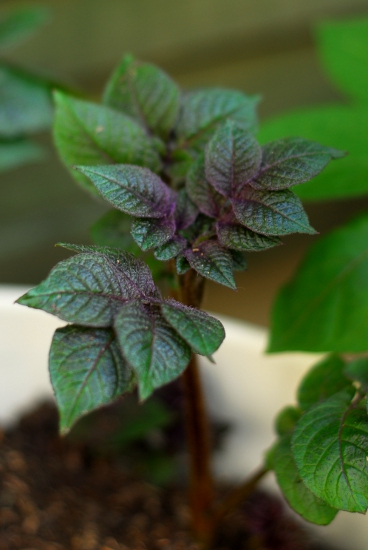
I was hoping that the plants would retain the colour as they grow. As the leaves get larger, however, they fall back to a more conventional deep green, with only the midrib and some of the larger veins keeping the red pigment. There is no sign yet, touch wood, of the leafhoppers which plagued our potatoes last year.
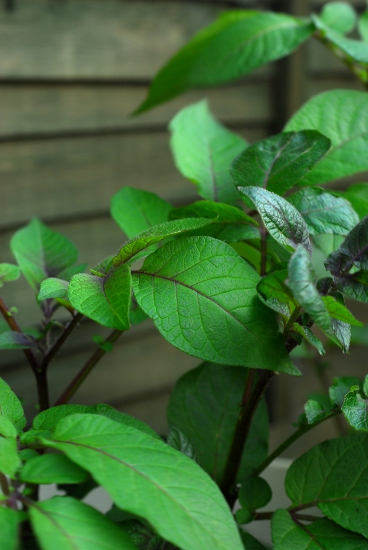
Two weeks ago, I sowed the main batch of courgette seeds, and was rather wary. We’ve not tried to grow them before, and I’ve heard stories of people having lots of trouble with them this year. However, in exactly 7 days every seed in the batch had germinated and was showing itself above the surface. I’ve killed off one as it was showing signs of rot, but the rest seem to be going well. They have started hardening up, and before they’re three weeks old should be ready for planting out.
One last thing for today: if you read Alys Fowler’s advice column in the Guardian Weekend magazine, you might have noticed last Saturday’s query about mossy containers. My mossy containers, that is: that was my letter! In particular, the container with our Swiss chard plants in, which developed a thick green carpet last autumn which didn’t seem to bother the plants at all. I shall stop worrying now that the moss might be bad for them.
courgette, pea, potato, swiss chard
Posted in Garden Diary, Photobloggery, Practicalities, The Old Garden In Bristol on Sunday, April 29th 2012 (1.59 PM).
It rained all last weekend; and since planting up the runner beans on Tuesday the rain has been essentially continuous. So I’m getting somewhat behind with the gardening, and getting more and more depressed about the state of the place. Gardening has been limited to poking the camera lens through the kitchen door, which is an angle I don’t normally try. The curly parsley decided, when the weather was hot over Easter, that it was time to bolt into flower. So far its flowers have not yet come out: maybe the rain has made it regret its decision.
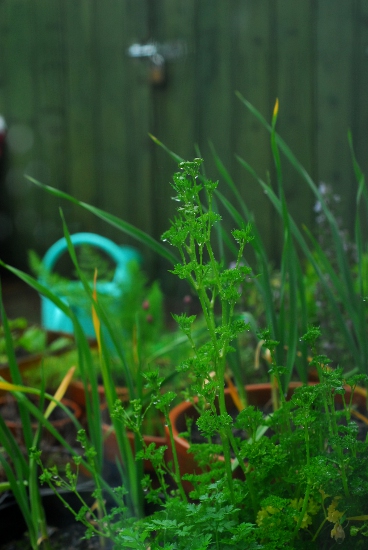
From that angle, the garden looks rather lush. It doesn’t feel that way when you’re standing in the middle of it. Moreover, the wet weather has prompted the local slugs and snails to mount a full-on attack of chewing. The garlic and fennel are too strongly-flavoured, but the runner beans and lettuces have survived a major hit, some of the pea plants are just hanging on, and a tray of coriander seedlings was completely destroyed, not a leaf left. Last night I went out twice, armed with scissors, and killed about eight slugs and five snails, stabbing the snails thoroughly and snipping the slugs in half. Well, it’s better for the rest of the garden than poison, and it definitely kills them before they can eat any more.
coriander, lettuce, parsley, pea, pest, rain, runner bean, slug, snail, spring, weather
Posted in Experimentation, Garden Diary, Planning, The Old Garden In Bristol on Saturday, April 7th 2012 (9.44 PM).
The long Easter weekend: time to catch up on the planting schedule, and get some digging done. In the past couple of weeks, we have:
- Planted more peas.
- Planted green beans and runner beans, to germinate on the windowsill
- Planted some coriander to grow from seed
It does feel as if I should be doing an awful lot more, given the season and the warming of the weather. It doesn’t help that Symbolic Towers has, literally, nothing more than a single windowsill for plant germination, and despite last week’s warm spell the ground still isn’t warm enough for outdoor plants to be moving very quickly.
The potatoes are springing up, though, with lovely dark red foliage. Unfortunately only two of the tubers seem to have grown, so I slyly slipped another into the depths of the container at the start of this week. No sign of it coming up yet; but it means that the earthing-up has become rather uneven, the soil inside the container now having a mountainous slope to it.
The first of the seeds we saved last autumn have been planted. Of a batch of six green beans, only one came up: it has been planted outside, with poles to climb up, and is looking a little lonely. Hopefully the next batch of green beans – put under plastic to germinate this time – will have a greater success rate. At least the bamboo poles give the garden some height, something that has been missing since last year’s batch of beans was finally cut down last November. The second batch of peas has now been planted out too; the first are a tangled mass of interlocking tendrils quickly climbing up each other’s arms.
What will be coming next? Well, there are still more potatoes to plant. Moreover, with the drier weather I’ve been able to restart work on digging up the back bed. I think I mentioned that project back when this blog first started: basically, as the walled bed at the back of the garden was full of broken glass and bindweed roots, we decided to dig it all out completely and sift through all the earth; I didn’t fancy, some time in the future, to plunge my fingers into the ground without thinking and stab them on a pointy shard. It has taken a while, but the end of the digging-up project is starting to come into sight; and when it does, maybe next month, we will have an awful lot more growing space to play with. So much, in fact, I’m not entirely sure what we will do with it all. Maybe it’s time I started looking into perennial vegetables that don’t mind a slightly shady spot.
back bed, coriander, green bean, pea, potato, runner bean, sowing, sowing plan, spring
Posted in Garden Diary, Photobloggery, The Old Garden In Bristol on Thursday, March 22nd 2012 (10.09 PM).
Back in January, I mentioned that all the rosemary in Southville seemed to be blooming. I said at the time that our own rosemary bush seemed to be slowly coming into bud: two months later, it is starting to flower. On Sunday, I noticed one solitary bloom:
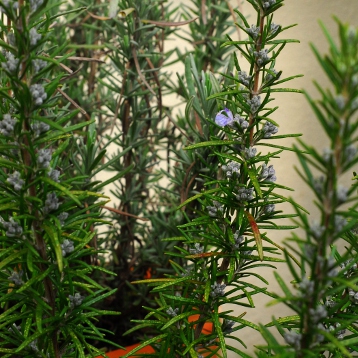
Today, there are rather more: I will have to try to get a less lonely-looking shot.
Yesterday, I spotted that the peas sown last Saturday, and the radish seeds sown back on the 11th, are both starting to poke themselves above the ground now. Looking back, I apparently didn’t mention the radishes when I planted them. Last year we grew several batches from a variety packet called “Rainbow Mixed”: they were good for science experiments but not much else, as almost all the plants we grew produced lots of foliage but hardly any root. From a box of radishes, we would get maybe one or two which had roots worth eating. This year, then, I’ve picked a different variety, a German type called “Ostergruß Rosa”, sold in this country under the Eden Project’s brand name. Supposedly they should turn out with long, French Breakfast-style roots. We shall have to wait and see.
blossom, flowering, pea, radish, rosemary
Posted in Experimentation, Garden Diary, Retrospective, The Old Garden In Bristol on Saturday, March 17th 2012 (3.59 PM).
A bit nippy out in the garden today: most certainly not as springlike as other days, with dark clouds massing overhead. Not at all like the warm, insect-filled garden of last weekend. Still, I did the things I meant to do: replanted the pea seedlings in their final location, sowed more peas to germinate on the windowsill, scattered a few “surprise” annual flower seeds in spare corners, and retreated to the sofa before the rain broke.
The pea seedlings have, like last year, gone in a box to stand on the garden wall. I should have transplanted them earlier: they were getting rather stuck in their tiny modules. The next batch of peas will start their hardening-up rather earlier, so they can be transplanted outside rather earlier too. The fennel I repotted last week is looking nicely at home, plenty of feathery new growth coming from the heart of both plants. The sweet peas are not so happy, still looking rather listless and floppy, so I have given them a bit more scaffolding to climb up: horizontal strings wrapped around their cane pyramid.
I said last time that I would explain a bit more about the fennel, and why we decided to get some. It is, essentially, to make up for last year. We tried to grow dill last year, and it was a bit of a failure.
If you look at a packet of dill seeds, you see a rather idealised picture: a big pot with a big dill plant inside it, leaves pouring down like a waterfall. Of course, if you’re growing dill for food, that’s what you need, because you need a good bunch of the individual fronds to put in your gravadlax. However, trying to grow dill from seed, that wasn’t what we got at all. The first plants we sowed in modules and tried to pot on: that failed entirely. The second plants we sowed in their final location; they put out a few leaves, then immediately bolted to a few feet high and flowered. Hardly any leaves at all, not even enough to make a single meal out of. The flower heads are pretty: finely-divided cadmium-yellow umbels; but, to be honest, I like eating dill too much to be satisfied with that. Why did it happen? I suspect the pot we put them in was rather too shallow, and the plants’ roots felt rather too cramped for comfort.
Now, in all the books I’ve read, it says: “don’t grow dill and fennel together”. They might give a reason, too, but if they have I haven’t absorbed it, come away only with the idea that they don’t work well together for some reason. I picture the real explanation being like primary school parents’ evening: “honestly, we love little Fennel, and he’s fine on his own, but when him and Dill get together they do tend to egg each other on. Mrs Anderson still can’t bear the sight of pencil shavings, and it was four months ago now…” Anyway, whatever the reason is, as we were trying to grow dill last year, we thought that fennel must be avoided at all costs. As I’m now completely exasperated with trying to get dill to grow, this year it is the fennel’s turn. We don’t have room for more than a couple of bulbs, so we won’t get more than a single side dish from it at the end of the season – fennel gratin is delicious, by the way. I’m more interested to see if its leaves can be used like dill, or if they will end up as purely structural plants for the summer – hopefully they will give the garden a more delicate sense of height than things-up-canes can provide.
dill, fennel, pea, sweet pea
Posted in Garden Diary, Photobloggery, The Old Garden In Bristol on Monday, March 5th 2012 (7.23 PM).
The peas planted last weekend were showing the first signs of poking up above the soil five days later, on Friday. By yesterday, the seedlings appeared to be coming on well.

Those peas are the ones we sowed for planting out in the garden later; there is no sign of the variety we sowed for pea shoots yet. There is also no sign, apart from a little ground disturbance, of the seeds I sowed outdoors. Of course, the peas, inside on the kitchen windowsill, have something of an advantage. Other things are doing well, though. I said just over a week ago that the first shoots of chives had started to appear. They have been coming on fast: getting on for a couple of inches, they are now big enough to photograph.
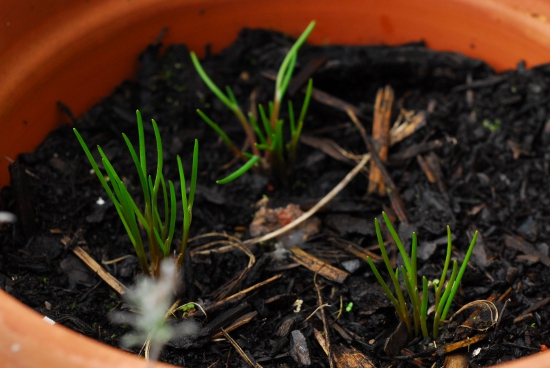
chives, pea, seedling, spring, sprouting
Posted in Experimentation, Garden Diary, The Old Garden In Bristol on Wednesday, February 29th 2012 (5.51 PM).
In the last post, I mentioned that although the rocket is in bloom already, there weren’t any hoverflies about yet. The very next day, I saw the first I’ve seen this year. Orange and black, it had gone before I had chance to grab the camera. It was warm in Sunday’s sunshine, and I could occasionally also hear bumblebees nearby – presumably queens looking for a nesting spot. The only one I saw was a good twenty feet away, not quite close enough to attempt an identification.
I was in the garden, because I’d decided that, with the weather being so warm, it was about time I started getting some seeds in the ground. Don’t want to leave it too late, after all: last year, because of when we started, we didn’t exactly grow the mixture of things we wanted. So Sunday was spent clearing compost out of all the pots which had had last year’s annuals in, and sowing a very few new seeds. In one pot: a mixture of calendulas and lettuce. A bit of an experimental mixture, and I’m not at all sure I have given them enough space to get along. Indoors, on the kitchen window sill: peas, germinating inside to avoid tempting the local wildlife. Peas are damn tasty, after all.
calendula, hoverfly, lettuce, little gem, marigold, pea, sowing, spring, wildlife
Posted in Experimentation, Garden Diary, Photobloggery, Planning, The Old Garden In Bristol on Sunday, January 15th 2012 (11.21 AM).
Given the crisp winter weather yesterday, we went out for a walk: down to Spike Island, along the New Cut, then back round in a circle through the back streets of Southville. I noticed, all of the rosemary bushes in the front gardens of Southville are in flower at the moment. Even in January.
The rosemary bush in our garden on the other side of the city is not in flower. I say “bush”: possibly “sprig” is a slightly better word. There are signs, though, that it might be starting to bud, pale green growing tips at the base of each leaf. Something is developing, at least; I don’t know much about rosemary yet.

In other news, we’ve been trying to do a bit more planning on what to grow this year. We had a good harvest last year from the peas we planted, but before the season was over the plants were suffering rather badly from mildew, possibly because we planted slightly too many in each box – after all, when you only have so much space it is tempting.
I have no idea what pea variety we grew last year. Towards the end of the planting season, we popped down to the garden centre, bought whatever type of pea seedlings they had available, and that was that. “Pea” was all it said on the label. For this season, therefore, we have deliberately gone out and bought seed of a disease-resistant variety: P. sativum “Boogie”. Whether they are as tasty or fruitful as last year’s anonymous ones, we will have to wait and see, but the packet of seed peas is ready and waiting in the seed tin.
boogie, bristol, disease, flowering, mildew, pea, rosemary, southville, unseasonal, winter
Posted in Retrospective, The Old Garden In Bristol on Saturday, October 1st 2011 (11.10 AM).
The list, in the previous post, of plants we’ve grown this year wasn’t really in any particular order; just off the top of my head as I cast my mind around the garden. Here, though, are some of the plants that we can say were a success.
Potatoes: probably our biggest success, grown in a dustbin with holes drilled in the bottom. We grew them in a mixture of soil and compost, at first, earthing up regularly with compost until it reached the top of the bin. I was expecting flowers and fruit, which we didn’t get; and we were rather worried about a leafhopper infestation which developed, damaging the leaves quite a bit. When the foliage died back, though, we upended the bin and found a healthy crop, about 600g per seed. Next year, we hope to have room for a couple more bins.
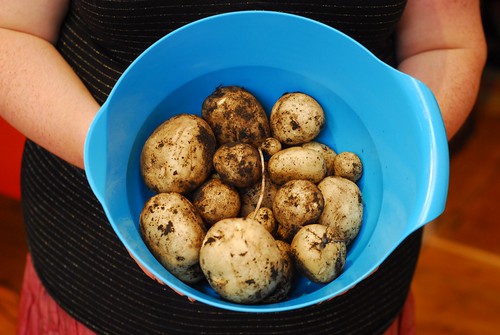
Peas: we bought small plants from the garden centre, planted them up in wine boxes, and put them on top of the garden wall, trained up the latticework. Again, each plant gave us a plentiful harvest; but we did have a bit of a mildew problem, probably caused by planting too many in each box.
French marigolds: we didn’t manage to eat any, but the plants themselves have gone happily on producing flowers all summer. They’re still in flower now, with more buds on the way.
Swiss chard: we planted this in a variety of containers, and tried harvesting and eating it at a variety of stages, from baby leaves to fully-grown leaves and stems. All of them worked pretty well: the baby leaves were ready fairly fast, and harvesting most of those left room for a few plants to grow into adulthood. Moreover, what we weren’t expecting was that we would be able to treat the adult plants in a cut-and-come-again fashion; we thought we’d harvested everything we could a few weeks back, but we now have healthy and harvestable leaves waiting for us again.

Mint: it grew, despite the best attempts of leaf-miners and caterpillars to eat it. Moreover, we kept forgetting we had mint leaves to use, leaving the mint bush to get rather overgrown and straggly; giving it a fierce trim rather more often would have left us with a healthier plant.
Feverfew: it grew very well, with attractive clusters of daisy-like flowers that have lasted well all summer. Now, we just have to work out what else it might be useful for.

calendula, feverfew, french marigold, marigold, mint, pea, pentland early, potato, review, swiss chard
Posted in Experimentation, Garden Diary, Photobloggery, The Old Garden In Bristol on Wednesday, September 7th 2011 (10.14 PM).
Since the last “week in the garden” post, we have:
- Harvested the first green beans.
And, because we went away for a long weekend, that was about it. The garden didn’t take too kindly to us going away, either. Or, rather, it didn’t take too kindly to the weather: the combination of dry, hot days without us there for watering, followed by heavy rain, has not had good results. The spring onions have suffered in particular, and the runner beans have also had problems.
Back in the mists of time – well, August – before this blog had properly started, we sowed a few boxes of quick-growing things to give us some more produce into the autumn. As I mentioned then, I tried an experiment. All of the seeds were sowed into previously-used compost; and for each seed, I sowed one box into compost that had been used to grow peas, and one box into compost that hadn’t. It’s three-and-a-half weeks later now, and the results are pretty clear, at least for the radishes.
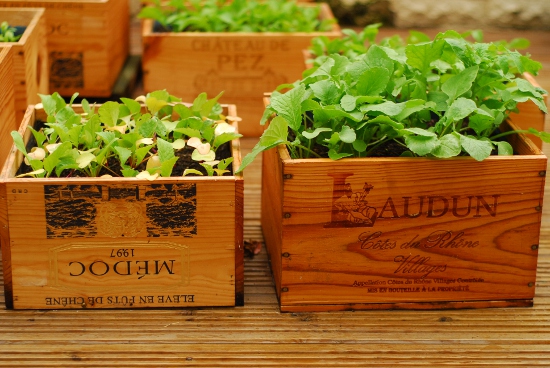
The pea compost is, I’m fairly sure, the one on the right. Science!
bean, compost, diary, experiment, french bean, green bean, nitrogen, pea, radish, scallion, science, spring onion, weather
Posted in Garden Diary, The Old Garden In Bristol on Saturday, August 13th 2011 (6.59 PM).
This week we have:
- Pulled up the pea plants, post-harvest, and dug them in to the back bed
- Pulled up the English marigolds, and the rocket that had gone to seed
- Re-sowed the boxes this freed up: two with radishes, two with rocket, and two with mixed salad leaves
- Sowed the last of our Swiss chard seeds in a spare half-box.
In the name of Science, I sowed the new boxes in an experimental pattern. All of the boxes had the existing compost thoroughly turned over to dig in the roots that had been growing there before, then had extra compost added to top them up. For each of the three types of seeds, we sowed one box which had been growing peas, and one which had been growing something else. We’ll see if the nitrate-fixing effect of the pea roots is noticeable. My suspicion is: it won’t be, especially for fast-growing plants like the radishes, because the pea roots won’t rot down fast enough.
chard, diary, experiment, pea, radish, rocket, sowing, sowing plan, swiss chard

